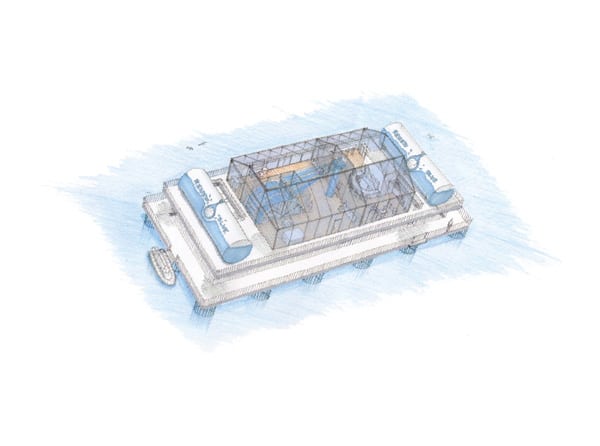Wave Energy Device to Tap Marine Energy in Gulf of Mexico
The U.S. Army Corps of Engineers earlier this year awarded its first Section 10 permit ever to a commercial wave-powered demonstration facility planned for installation in the Gulf of Mexico. The novel offshore platform, dubbed the SEADOG, will use a buoy and piston mechanism combined with a water wheel to generate electricity and desalinate water.
The SEADOG is essentially based on an air-filled buoyancy block within a cylindrical chamber. The chamber stays relatively stationary while the block rises and falls with the waves. The motion of the block moves a piston within a cylinder, drawing in and expelling water with every stroke. By adjusting the piston size, the same size pump can be deployed to pump larger amounts of water to lower elevations, or smaller amounts to greater elevations, the device’s owner, Minnesota-based Independent Natural Resources Inc. (INRI) says.
According to the company, the planned facility will comprise a 150-foot by 75-foot platform installed 1 mile offshore (Figure 7) that will be equipped with 18 wave pumps. Each pump, 7 feet in diameter, will send water up through three water wheels connected to a generator. The pumps themselves will work 25 feet below the surface of the water and be able to generate about 60 kW. About 4 kW of this power will be used to run a standard reverse osmosis desalination machine to produce 3,000 gallons of freshwater per day.
 |
| 7. On the crest of a wave. The SEADOG, an offshore platform planned for installation in the Gulf of Mexico this year, will employ 18 underwater pumps to extract mechanical energy from each wave and use that energy to desalinate water. Courtesy: Independent Natural Resources Inc. |
The SEADOG permit was awarded less than eight months after the company received the first-ever state offshore wave energy lease from the Texas General Land Office for the facility. INRI had already installed a prototype of the pump in the Gulf of Mexico in 2007. The company claims that modest waves ranging from only 6 inches to 6 feet created enough movement to allow the SEADOG pump to lift water approximately 110 to 125 feet. It hopes to put the larger platform in the water by the end of this year.
The wave energy project will be one of the first to be deployed in the Gulf of Mexico. The U.S. has been trailing the world in developing marine energy projects, though some companies have made significant advances. New Jersey–based developer Ocean Power Technologies recently launched a $4 million project that could become the nation’s first commercial wave power farm off the coast of Reedsport, Ore. And in May the Federal Energy Regulatory Commission issued a preliminary permit for Pacific Gas & Electric Co.’s Central Coast WaveConnect pilot program off the coast of Santa Barbara, Calif.
But wave energy projects continue to be at the mercy of funding from public, private, and government entities. Large initial installation costs hinder even promising projects from becoming operational. And even projects that succeed technologically have failed for lack of funding. A prime example is the world’s first commercial wave farm, which opened in 2008 off the coast of Portugal. The 2.5-MW Aguçadoura Wave Park ran into financial difficulties last year and was suspended indefinitely.
Some governments continue to foster marine energy development. The UK recently poured £8 million into the European Marine Energy Research Centre in Scotland, which will serve as a testing facility for technology developers. The UK has also set up a £22 million fund to offset large capital costs during the installation stage. And in July, Scotland awarded £13 million to five project bidders contending for government’s Wave and Tidal Energy: Research, Development and Demonstration Support program. Awardees include one of the world’s largest wave stations being developed off the Western Isles by RWE npower renewables and a doughnut-shaped wave energy converter being tested in Loch Ness by AWS Ocean Energy.